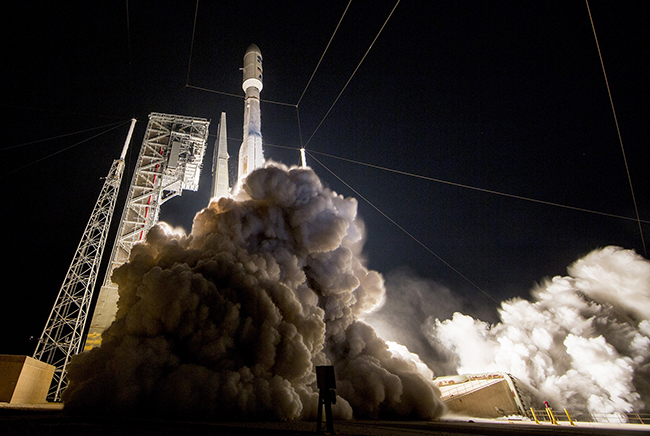
The 45th Space Wing supported NASA’s successful launch of the Geostationary Operational Environmental Satellite-R spacecraft aboard a United Launch Alliance Atlas V rocket from Space Launch Complex 41 at Cape Canaveral AFS, Fla., on Nov. 19, 2016. ULA courtesy photo via USAF.
The Air Force on Friday night published a final request for proposals for Phase 2 of the National Security Space Launch program, signaling confidence in its way forward even as industry and lawmakers have raised questions about the initiative’s viability.
NSSL aims to find companies whose rockets can replace the Russian-built RD-180 engine, which powers United Launch Alliance’s Atlas V. The Air Force so far has offered seed money to contractors developing rocket and engine prototypes in an attempt to broaden the space launch market to new competitors and reusable vehicles.
Two companies that offer the best value will win contracts in the second quarter of fiscal 2020. Their rockets will later launch satellites into orbit for national security missions. Any company can compete, regardless of whether they received a Launch Services Agreement award. ULA, Northrop Grumman, Blue Origin, and SpaceX are expected to enter their respective rocket designs.
“Last year, the Space and Missile Systems Center awarded three developmental Launch Service Agreements to Blue Origin, Northrop Grumman Innovation Systems, and United Launch Alliance to ensure their respective launch systems—New Glenn, OmegA, and Vulcan—are able to meet the more stressing National Security Space requirements,” the Air Force said in a release. “In addition, the Air Force also competitively awarded nine launch services to SpaceX using their Falcon 9 and Falcon Heavy launch vehicles over the last two years, and SpaceX successfully launched the first of those nine missions on Dec. 23, 2018.”
The Air Force is buying launch services from 2020-2024 for missions through 2027, which will include National Reconnaissance Office payloads as well. One winner will handle 60 percent of the missions, with the other 40 percent.
The companies’ bids will be judged on technical merit and risk, past performance, small business participation, and price. Chosen contractors can receive $10 million in incentive pay per mission, paid out in periodic installments.
In the months leading up to the final RFP’s release, members of Congress sparred with Air Force officials over whether the service was unfairly restricting competition by whittling down to two awardees or if it had thought out other aspects of its program strategy. Some industry executives argued the Air Force is on the right path, while others pushed for a delay so the program could be tweaked.
But the Air Force has decided to move forward as is.
“We must move forward now. We are answering Congress’ 2014 directive to transition off the Russian-made RD-180 rocket engine,” service Secretary Heather Wilson said in the release. “The industrial base is ready and we will keep our most demanding National Security Space orbits on track.”
The overall procurement effort, formerly known as the Evolved Expendable Launch Vehicle program, is slated to total $19.6 billion, according to the Air Force’s 2020 budget documents.